
Belo Horizonte is the sixth-largest city in Brazil, with a population of around 2.3 million, and the third largest metropolitan area, containing a population of 6 million. It is the 13th-largest city in South America and the 18th-largest in the Americas. The metropolis is anchor to the Belo Horizonte metropolitan area, ranked as the third most populous metropolitan area in Brazil and the 17th most populous in the Americas. Belo Horizonte is the capital of the state of Minas Gerais, Brazil's second-most populous state. It is the first planned modern city in Brazil.

Coimbra is a city and a municipality in Portugal. The population of the municipality at the 2021 census was 140,796, in an area of 319.40 square kilometres (123.3 sq mi). The fourth-largest agglomerated urban area in Portugal after Lisbon, Porto, and Braga, it is the largest city of the district of Coimbra and the Centro Region. About 460,000 people live in the Região de Coimbra, comprising 19 municipalities and extending into an area of 4,336 square kilometres (1,674 sq mi).

Goiânia is the capital and largest city of the Brazilian state of Goiás. With a population of 1,536,097, it is the second-largest city in the Central-West Region and the 10th-largest in the country. Its metropolitan area has a population of 2,890,418, making it the 12th-largest in Brazil. With an area of approximately 739 square kilometres, it has a continuous geography with few hills and lowlands, with flat lands in most of its territory, especially the Meia Ponte River, in addition to Botafogo and Capim Puba streams.
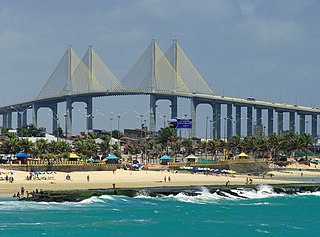
Natal is the capital and largest city of the state of Rio Grande do Norte, located in northeastern Brazil. According to IBGE's 2022 estimate, the city had a total population of 751,300, making it the 24th largest city in the country. Natal is a major tourist destination and an exporting hub of crustaceans, carnauba wax and fruits, mostly melon, sugar apple, cashew and papaya. Natal is Brazil's closest city to Africa and Europe, its Greater Natal International Airport connects the city with many Brazilian destinations and also operates some international flights. The city was one of the host cities of the 2014 FIFA World Cup.

Costa da Caparica is a Portuguese city and civil parish, located in the municipality of Almada along the western coast of the district of Setúbal. The total population in 2011 was 13,418, in an area of 10.18 km2. Since 9 December 2004, the Costa da Caparica has been designated as cidade within the urban hierarchy of Portugal.

The Parque das Nações, colloquially known as Expo, is a freguesia and typical quarter of Lisbon, the capital city of Portugal. Located in eastern Lisbon, Parque das Nações is to the east of Olivais, northeast of Marvila, and directly south of Lisbon's border with Loures. The population in 2021 was 22,382.

The Arena das Dunas is a football stadium in Natal, Brazil. It has a capacity of 31,375 spectators, and was designed by sports architect Christopher Lee of Populous. The stadium hosted football matches for the 2014 FIFA World Cup held in Brazil. During the tournament, it had a seating capacity of 42,000. It was built in place of the Machadão, which was demolished in 2011.
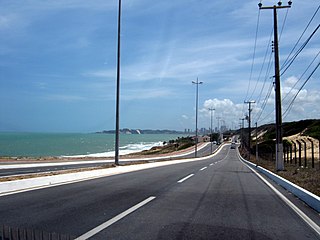
The Senador Dinarte Mariz Avenue, also known as Via Costeira is one of the most important avenues in Natal, Brazil.
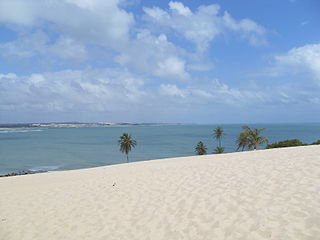
The Natal Dunes State Park "Journalist Luiz Maria Alves", or simply the Dunes Park is a state park in the state of Rio Grande do Norte in the Northeast Region of Brazil. It protects an area of dunes and native vegetation along the coastal highway.
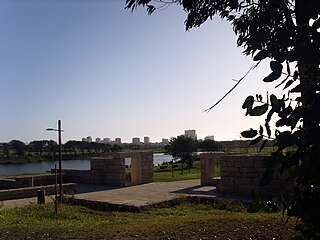
The Póvoa de Varzim City Park is an urban park of Póvoa de Varzim in Portugal.

Santa Clara is a freguesia and typical quarter of Lisbon, the capital city of Portugal. Located in northern Lisbon, Santa Clara is north of Lumiar, west of Olivais, and directly south of Lisbon's border with Odivelas and Loures. The population in 2021 was 23,645.

Grajaú is one of 96 districts in the city of São Paulo, Brazil.
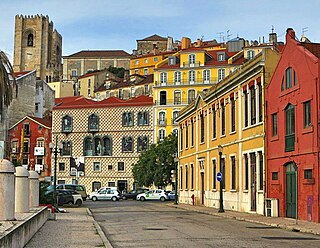
Lisbon is one of the most popular city destinations in Europe. The city of Lisbon and the Lisbon metropolitan area attracts a significant number of tourists each year, drawn to its historical and cultural heritage, good transportation connections and good touristic infrastructure.

André de Albuquerque Square, also popularly known as Red Square, is located in the Cidade Alta neighborhood, in Natal, capital of the state of Rio Grande do Norte. The square, named after the revolutionary André de Albuquerque Maranhão, who fought on the side of the Pernambuco rebels, marks the geodesic point of the city and also its zero milestone.
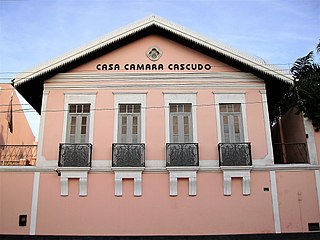
The Historic Center of Natal is a delimited area of 201,278 m² in the capital of the Brazilian state of Rio Grande do Norte. This section includes 150 buildings of diverse styles, including colonial, neoclassical, art deco and modernist architecture. It comprises the neighbourhoods of Cidade Alta and Ribeira and some buildings of the neighbourhoods of Tirol and Petrópolis, which are the oldest areas of the city and show characteristics of the first centuries of Brazil's history and important aspects of Portuguese colonization.

Tourism in the city of São Paulo stands out more for its business tourism than recreational tourism. However, cultural tourism is also important for the city, especially due to the several international events that take place in the region, such as the Art Biennial, the International Film Festival and the different performances with foreign celebrities that normally only happen on the Rio de Janeiro-São Paulo axis. The city has an average of one event every six minutes and between 410 and 550 hotels, offering visitors a total of between 42,000 and 50,000 rooms.

Burle Marx Park is located in the Vila Andrade district, in the Brazilian city of São Paulo. It offers a contemplative proposal aimed at preserving the remnants of São Paulo's Atlantic Forest, similar to the Carmo and Anhanguera parks. Inaugurated in 1995, it was inspired by the design made by Roberto Burle Marx for the gardens of the mansion that Baby Pignatari started to build on the site. The house, which was never finished, was later demolished and the gardens that had been planted were reused for the park.
TV Universitária Rio Grande do Norte is a Brazilian television station based in Natal, capital of the state of Rio Grande do Norte serving as an affiliated of TV Brasil for the entire state. Of an educational nature, it is subordinate to the Communication Superintendence (COMUNICA) of the Federal University of Rio Grande do Norte, which also includes the FM Universitária radio station and the Communication Agency (Agecom). The station's headquarters are on the UFRN university campus, in the Lagoa Nova neighborhood, and its transmission antenna is on Morro Nova Descoberta, in Parque das Dunas.

The Serras do Porto Park is situated in the Porto Metropolitan Area, encompassing territories within the municipalities of Gondomar, Paredes, and Valongo. It is classified as a regional protected landscape. Covering an area of 5,974 hectares, the park was established in 2017, serving as a green lung for the densely urbanized region of Porto and its surrounding municipalities, which together form the second most populous urban area in Portugal.


















